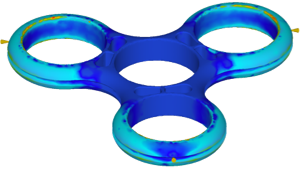Solidified plastic (end of fill) result
The Solidified plastic (end of fill) result shows how much of the plastic cross-section has frozen, or solidified, at the end of the filling phase.

Frozen layer
The plastic melt starts to solidify in the mold cavity wherever it touches the mold wall. The development of the frozen layer is described in this video. During filling, the frozen layer should maintain a constant thickness in areas with continuous flow because the heat loss to the mold wall is balanced by the hot melt coming from upstream.
Things to look for
When viewing the Solidified plastic (end of fill) result, watch for the following:
- The frozen layer, or solidified plastic, should not be greater than 20-25% anywhere in the part.
Using this result
The values for this result range from 0-100%. A higher value represents a thicker frozen layer, a higher flow resistance, and a thinner polymer melt or flow layer. A polymer is considered to be frozen when the temperature falls below the transition temperature (Ttrans). You can find the transition temperature for your selected material in the Material Properties page of the materials database.
At the end of filling phase, the frozen layer will still be relatively thin near the injection location, where fresh hot plastic helps to keep the plastic molten. The frozen layer throughout the part at the end of the filling phase should not exceed 20-25%. Higher values will make the part difficult to pack out. Areas of the mold that are filled early in the cycle, but have little subsequent flow, normally have the highest frozen layer fraction.
Next steps
The following options can be used to reduce the solifified plastic at the end of the filling phase:
- Decrease the injection time to inject the melt more quickly, which reduces the frozen layer fraction due to increased friction.